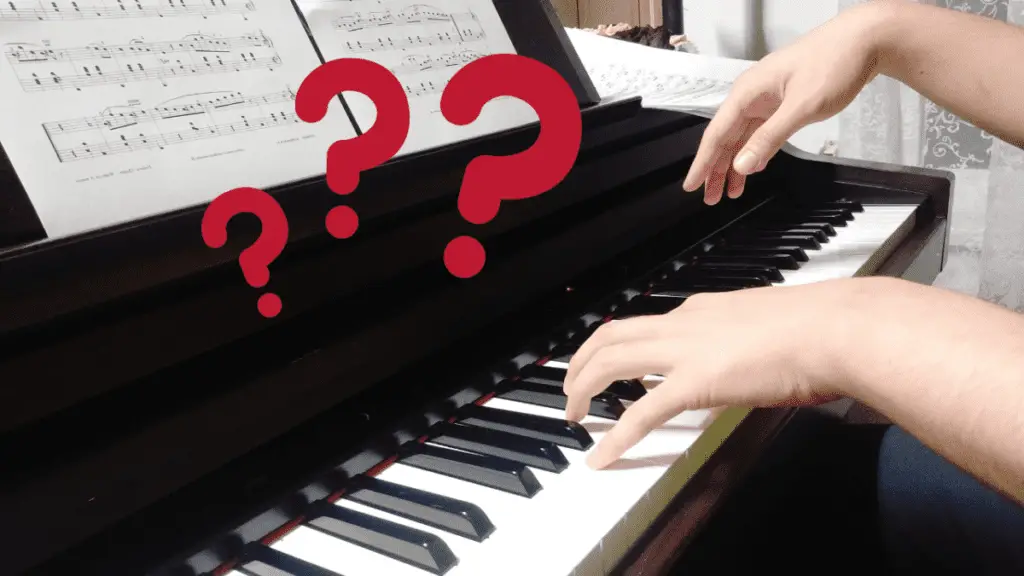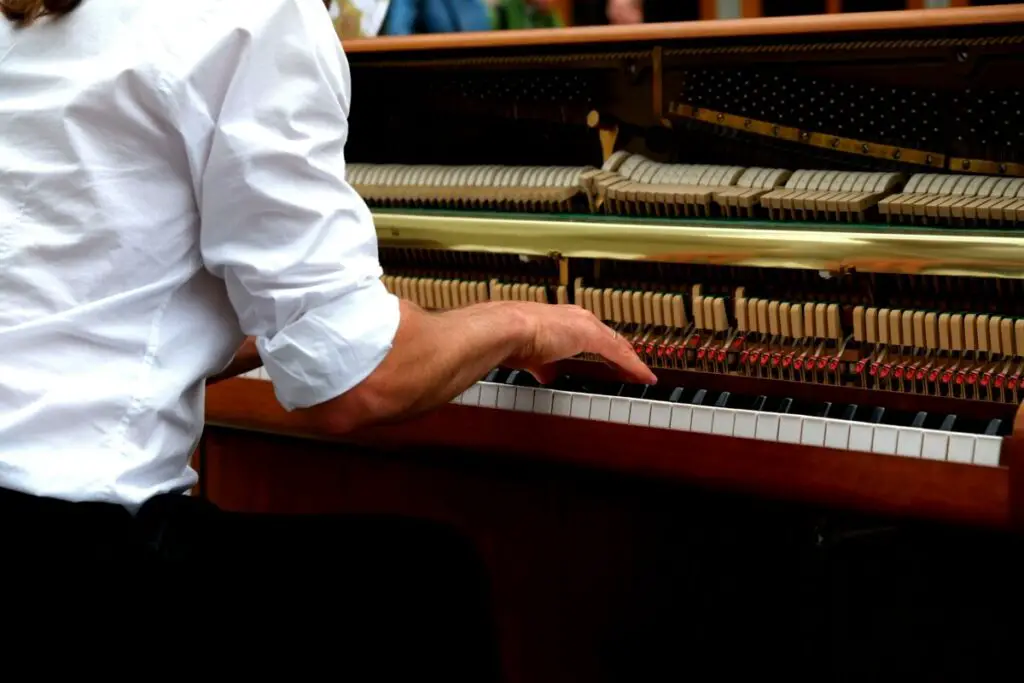This post contains affiliate links.

We have all seen piano concerts or competitions videos where the pianists would lift their hands and fingers high off the keys, sometimes way past their shoulders and above their heads. Although it looks impressive, does lifting your fingers like that have any effects on your piano playing?
You can lift your fingers slightly off the piano keys to produce louder sounds. You can also briefly lift your hands to release tension in the wrists and fingers. However, you shouldn’t lift your fingers above your head since it’s an inefficient movement that adds nothing to the sounds.
In this article, I’ll go through some reasons why pianists lift their hands and fingers while playing the piano and whether or not you should copy them. I’ll also talk about whether it’s ok to lift fingers that aren’t playing any notes.
Why do pianists lift their hands?
Pianists lift their hands to add a dramatic effect to their piano playing and to express emotions while having no impact on the sounds. They also lift their hands to produce a louder sound or to release tension in the wrists and fingers, making them nimble again.
Showmanship purposes
The reason why pianists lift their hands past their shoulders while playing is to express their emotions. During the performance, there are moments where strong emotions arise and are felt by the pianist, who decides to release them through grand lifting motions of their hands. This also visually emphasizes certain notes or passages the pianist was playing.
However, in this case, the hand lifting is only for looks and so is optional, lifting hands past your shoulders has no impact on the sound since you can play loud notes with fingers slightly higher off the key. If you only listen to a performance without watching it, there’s no way to know if, at any point, the pianist lifts their hands high above the keys.
With that said, if the pianist was competing in a piano competition, lifting their hands high off the key like that looks impressive to the audience. The audience enjoys a performance that is different than the rest, giving the pianist a better chance of winning.
For example, in Dang Thai Son’s performance of Chopin’s Scherzo No. 2 in B-flat minor, Op. 31, there are many moments during the performance where he raised his hands past his shoulders.
In those moments, he could have played the piece and produced the same sounds with his hands closer to the keys, without the unnecessary hand raise.
However, you can’t deny it looks way more impressive the way he played the piece, making the performance much more memorable, especially at 8:44 when he ended the piece with sudden outward hand movements. For me, it looks as if he gained birds’ or butterflies’ wings with those outward hand movements.
To release tensions in their wrists and fingers
While performing, a pianist’s hands may stiffen up which can severely restrict hand movements, making it harder to play the rest of the piece. Stiff hands may be caused by keeping hands so close to the keys at all times.
This is why some pianists will briefly raise their hands to release tensions in their wrists and fingers, making them nimble again to continue with the rest of the piece.
To adjust the notes’ volumes
Generally, all pianists lift their fingers slightly higher off the notes so they can create louder notes.
This is due to how piano keys are designed to work: the resistance you feel when pressing down on a piano key is there to tell the hammers how quickly to hit the strings. If the hammers hit the strings quickly, loud sounds will be created. If the hammers hit the strings slowly, softer sounds will be created.
How quickly the hammers hit the strings depends on how fast you hit the keys. If you hit the keys quickly, the hammers will strike quickly and vice versa.
And to hit the keys quickly, your fingers need some space and time to accelerate, thus explaining why pianists lift their fingers slightly above the key to play louder notes while keeping their fingers on the keys when playing softer notes.
Remember to also use the weight of your arm and your wrist to play louder notes since only using your fingers is considered bad practice.
Aside from lifting their fingers way too high, you may notice that some pianists do odd things like swaying their bodies, making weird faces or moving their mouths. To find out the reasons why, check out 7 Quirky Thins Pianists Do During Performances
Should you lift your fingers past your shoulders when playing the piano?
While there are good reasons why to lift your hands off the keys (play louder notes and release tension), there aren’t any benefits to raising your hands past your shoulder aside from looking good.
This is why raising your hands past your shoulders is considered an unnecessary and inefficient movement that takes your focus away from the rest of the piece.
You shouldn’t raise your hands past your shoulders in piano pieces with fast tempos where you can’t afford to waste any movements.
Furthermore, many piano players overdo the “raising your hands past your shoulders”, to the point where it negatively affects the players’ playing while adding nothing to the sounds.
On the other hand, you may enjoy playing the piece more if you can add some personal touches to it, rather than playing the piece normally with no interpretation to make it your own.
Thus, raise your hands past your shoulders with moderation. Follow your intuition and only do so when it makes sense for you. Don’t lift your fingers just for the sake of looking good. Most piano teachers won’t object to doing this, as long as it doesn’t affect your piano playing.

Is it ok to lift fingers that aren’t playing any keys?
Ideally, you’d want to keep fingers that aren’t playing any keys on the keys since for most piano players, it’s the most relaxed position for your fingers to be in.
However, for some reason, you can’t help but keep raising the fingers that aren’t playing notes. Is this bad and should you fix it as soon as possible?
The answer is that it’s more important that the fingers that aren’t being used be in the most relaxed positions possible. So if it feels more natural for you to lift them as opposed to rest them on the keys, do so.
There’s no need to make an effort to either lift or keep them on the keys because doing so can cause fatigue which can stiffen your fingers. Playing piano pieces with stiff fingers is very bad as it severely restricts your hand movement.
It’s more important to focus on the fingers that are playing notes, not the fingers that aren’t.
Also, you may find that as you continue playing and improving at the piano, it’ll become easier for you to stop lifting fingers that aren’t being used because your fingers are getting stronger from practice. I also recommend you do scale exercises to further develop your finger strength and to stop lifting fingers that aren’t being used.
If you have no prior knowledge about practicing piano scales, I wrote a couple of articles that detail the benefits, how long does it take to learn all scales and how long should you spend practicing scales every day?
Can You Learn Piano Without Knowing Scales (and reasons why you should learn scales anyway)
How long does it take to learn piano scales?
How Many Piano Scales Should You Practice Every Day?
For me, most of the time, I keep fingers that aren’t being used on the keys. Sometimes, I would hover my fingers over the keys to prepare to reach for notes that are further away.

